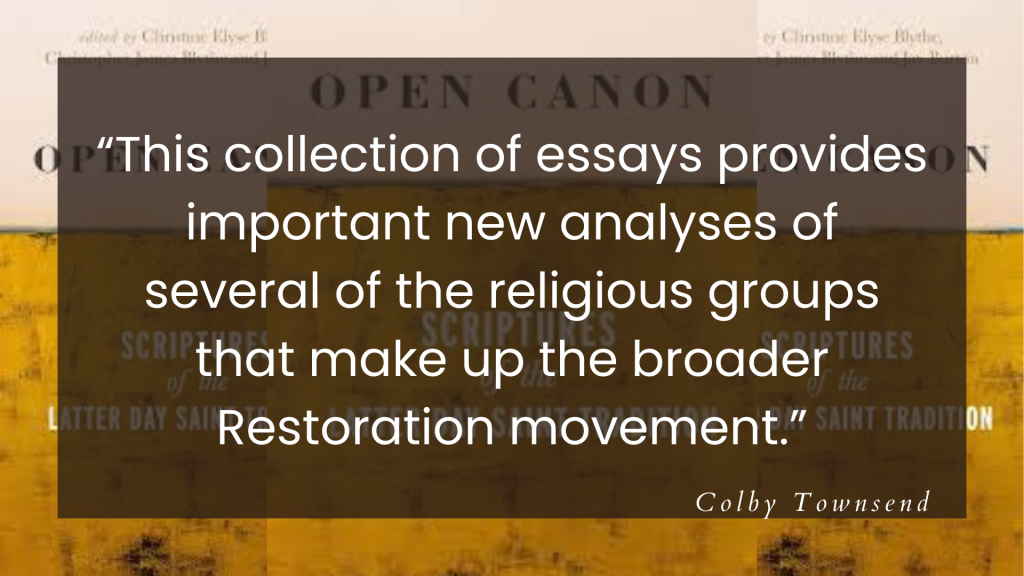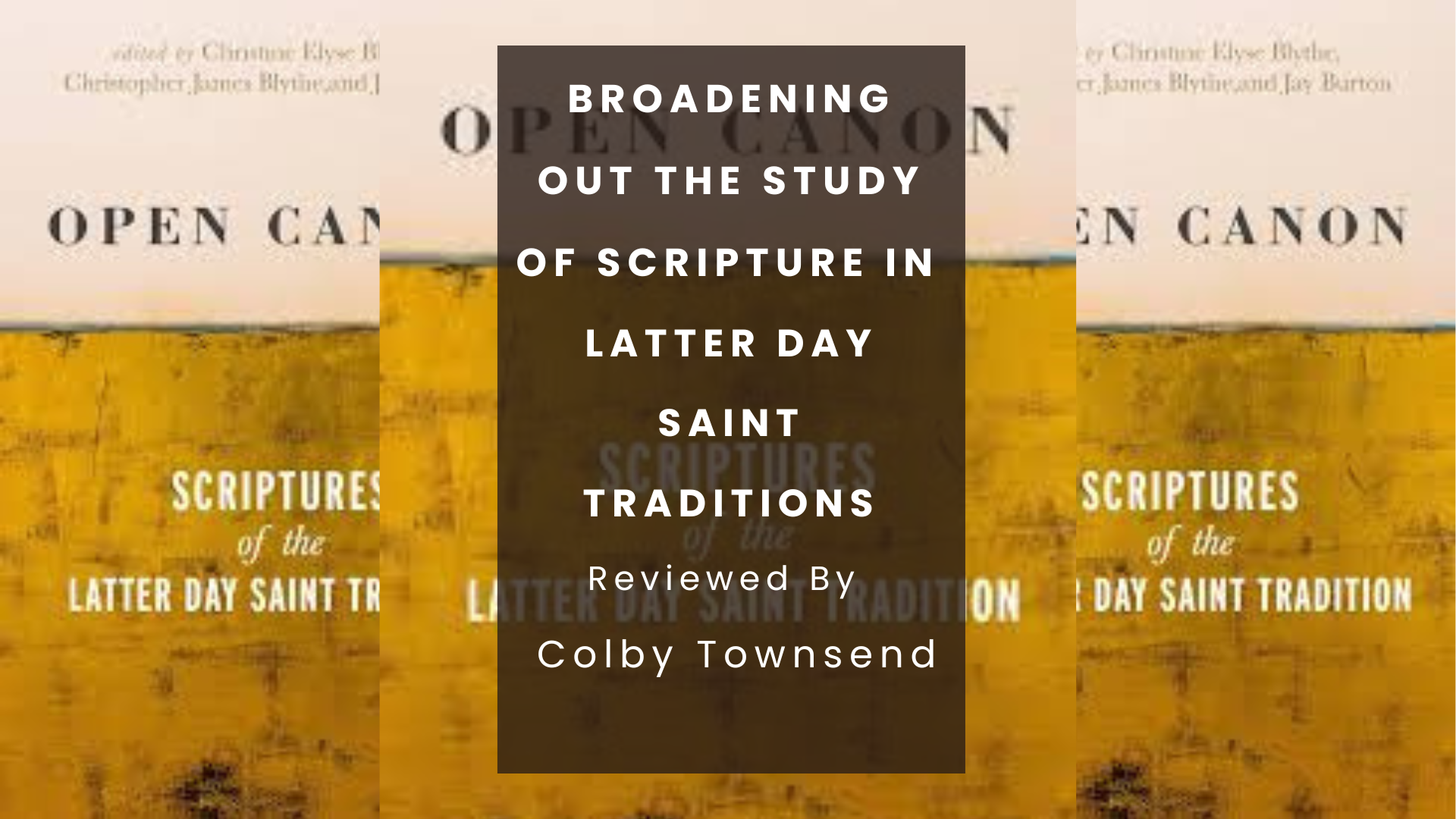Articles/Essays – Volume 58, No. 1
Broadening Out the Study of Scripture in Latter day Saint Traditions | Chrstine Elyse Blythe, Christopher James Blythe, and Jay Burton, eds., Open Canon: Scriptures of the Latter Day Saint Tradition
This collection of essays provides important new analyses of several of the religious groups that make up the broader Restoration movement begun by Joseph Smith Jr. in 1830, what the editors of this collection call the “Latter Day Saint tradition.”[1] While there has been considerable work done in recent years on the different religious groups that fall under this umbrella, very little of it has focused on the canonical traditions of the groups outside of the two largest organizations of the LDS Church and the Community of Christ (CoC). The majority of the essays in the volume consider scriptural traditions of the groups outside of these two churches, including the Church of Jesus Christ (Bickertonite), the Church of Christ (Temple Lot), and the Church of Jesus Christ of the Children of Zion. Other essays discuss lesser-known movements like the reception of Harry Edgar Baker’s early twentieth-century revelations, Earl John Brewer’s lost caves and found metal plates, and the House of Aaron. Most essays in this volume, especially those on the traditions outside of the LDS and CoC, could be turned into future books since so little has been written on these scriptural traditions. The editors deserve recognition for bringing attention to such an understudied area of broader Mormon studies.
The volume is split into four parts. The three essays in the first part, “Introductory Essays,” provide important context for the study of scripture within the broader Latter Day Saint tradition. In these essays, authors provide: an introduction (Christopher James Blythe); history so that the reader sees how deeply connected early Latter Day Saint tradition is with early American religious history (Laurie F. Maffly-Kipp); and a reflection on how the idea of diaspora helps to explain the splintering nature of the Latter Day Saint tradition after Smith’s death (Richard L. Saunders). The second part, “Reception of Joseph Smith’s Revelations,” provides four essays that analyze: how the LDS and CoC have read, printed, and understood the Book of Mormon in different ways (Joseph M. Spencer); how the Community of Christ (Temple Lot) has been a “solae scripturae” religious group, being more open to continuing revelation than broader Protestant Christianity while also focusing attention on the text of their religious canon (Chrystal Vanel); how the process of canonization works through analysis of how Smith’s letters from Liberty Jail were later canonized as revelations (Kathleen Flake); and finally, how the process of decanonization works, specifically through the reception of the Lectures on Faith and its removal from the LDS Doctrine and Covenants (Richard S. Van Wagoner, et al.).
Part 3, “Case Studies in New Scripture: Nineteenth Century,” begins to widen out the volume into analysis of the proliferation of groups within the Latter Day Saint tradition. This section includes essays on the reception of Lucy Mack Smith’s biography of Joseph Smith in several Latter Day Saint traditions (Janiece Johnson), the development of Strangite scripture (Christine and Christopher Blythe), Charles B. Thompson rewriting of the Book of Enoch (Christopher Blythe), William Bickerton’s approach to revelation and scripture (Daniel P. Stone), and Sidney and Phebe Rigdon’s revelations for the Church of Jesus Christ of the Children of Zion (Jay Burton).

Part 4, “Case Studies in New Scripture: Twentieth and Twenty-First Centuries,” moves into Latter Day Saint traditions that are still developing at the present day, including reception of Harry Edgar Baker (Thomas G. Evans and Christopher Blythe), the House of Aaron (Casey Paul Griffiths), the ongoing search for Earl John Brewer’s caves (Christopher C. Smith), and Matthew Philip Gill’s new movement (Matthew Bowman). This area, in particular, invites scholars to study these more recent movements within the tradition.
The essays in this volume do important work and their subjects of study deserve further attention. Not enough analysis has been done on these traditions, and I hope that scholars in Mormon studies will take up these important topics in their future work. This is true especially for the topics in parts 3 and 4. While there are many strong essays in this volume, some could benefit from critical pushback. I was surprised that in her essay, Janiece Johnson decided to leave out of her description the fraught relationship between Lucy Smith’s biography and the LDS tradition. Not only does Brigham Young’s strong (negative) response go unnoticed, but the essay also only mentions his statement that she was a “mother in Israel” (150). He had more to say about her biography that is relevant to the topic.
Similarly, Joseph Spencer’s argument that the LDS Church’s and CoC’s differing approaches to reading and printing the Book of Mormon means there were two completely different books is not a “reasonable” (75) argument from my perspective. It is not surprising that the two groups would have different approaches to the same work, as this is a normal part of the reception of books in general. The difference is at the level of editions and reading traditions, not that there are multiple works. Setting these rather small criticisms aside, I highly recommend this admirable new volume in Mormon studies. It will be a useful addition to any library, university, or home that includes American religion, literature, and Mormon studies.
Christine Elyse Blythe, Christopher James Blythe, and Jay Burton, eds. Open Canon: Scriptures of the Latter Day Saint Tradition. Salt Lake City: University of Utah Press, 2022. 379 pp. Paper: $39.95. ISBN: 9781647690823.
[1] The editors of this volume use the term “Latter Day Saint” instead of “Latter-day Saint” to signal to the reader that their interest is the larger Restoration movement begun by Joseph Smith Jr. and all of the groups that identify with it, rather than just the Church of Jesus Christ of Latter-day Saints.


 Back to full Issue
Back to full Issue

